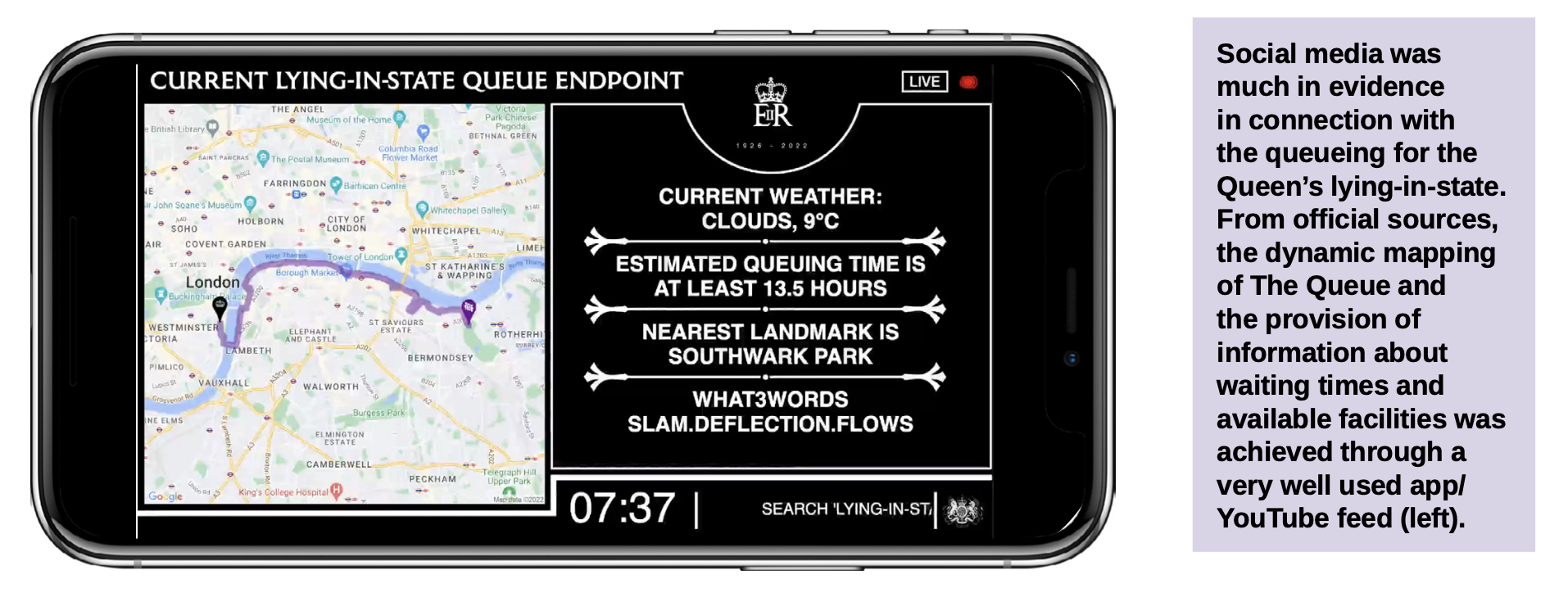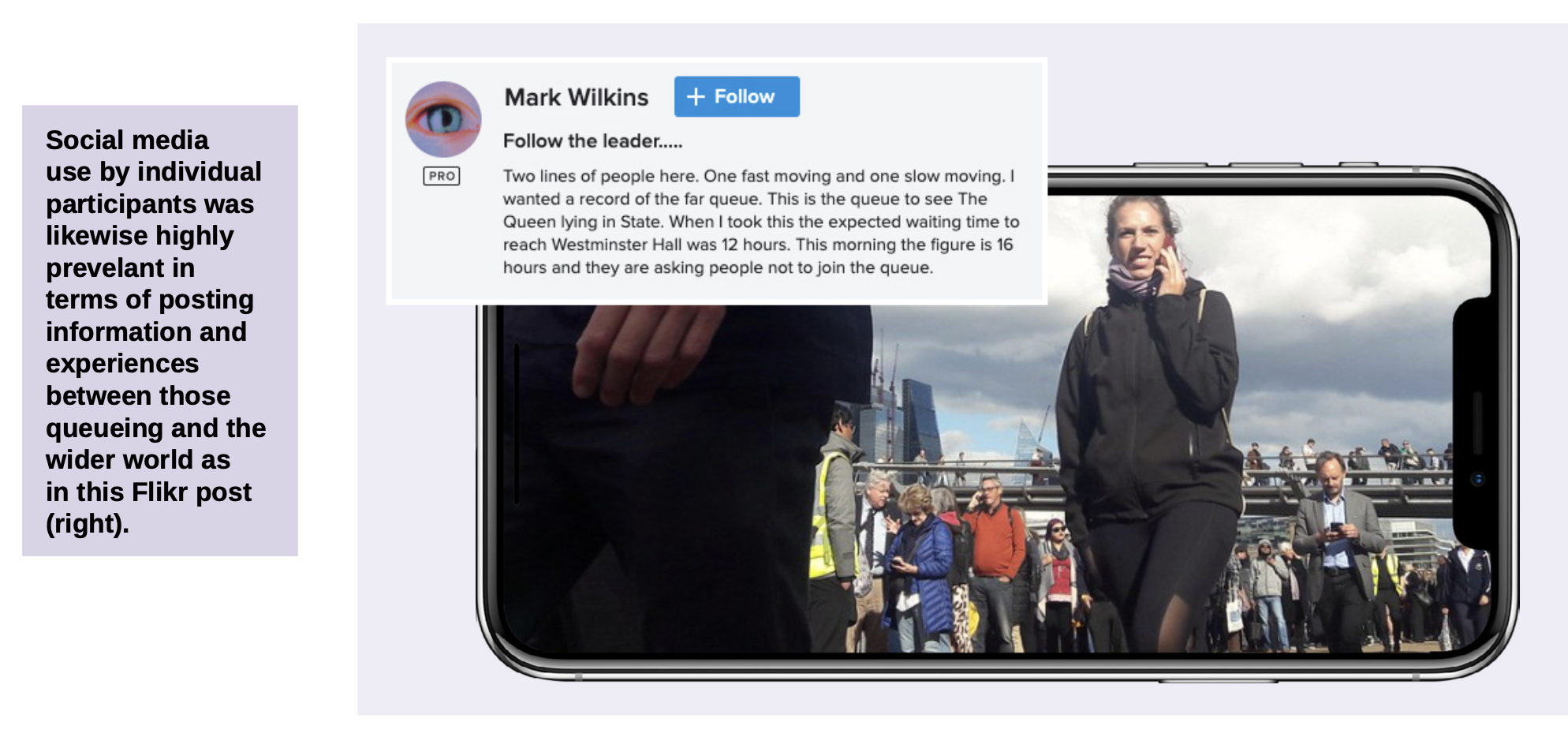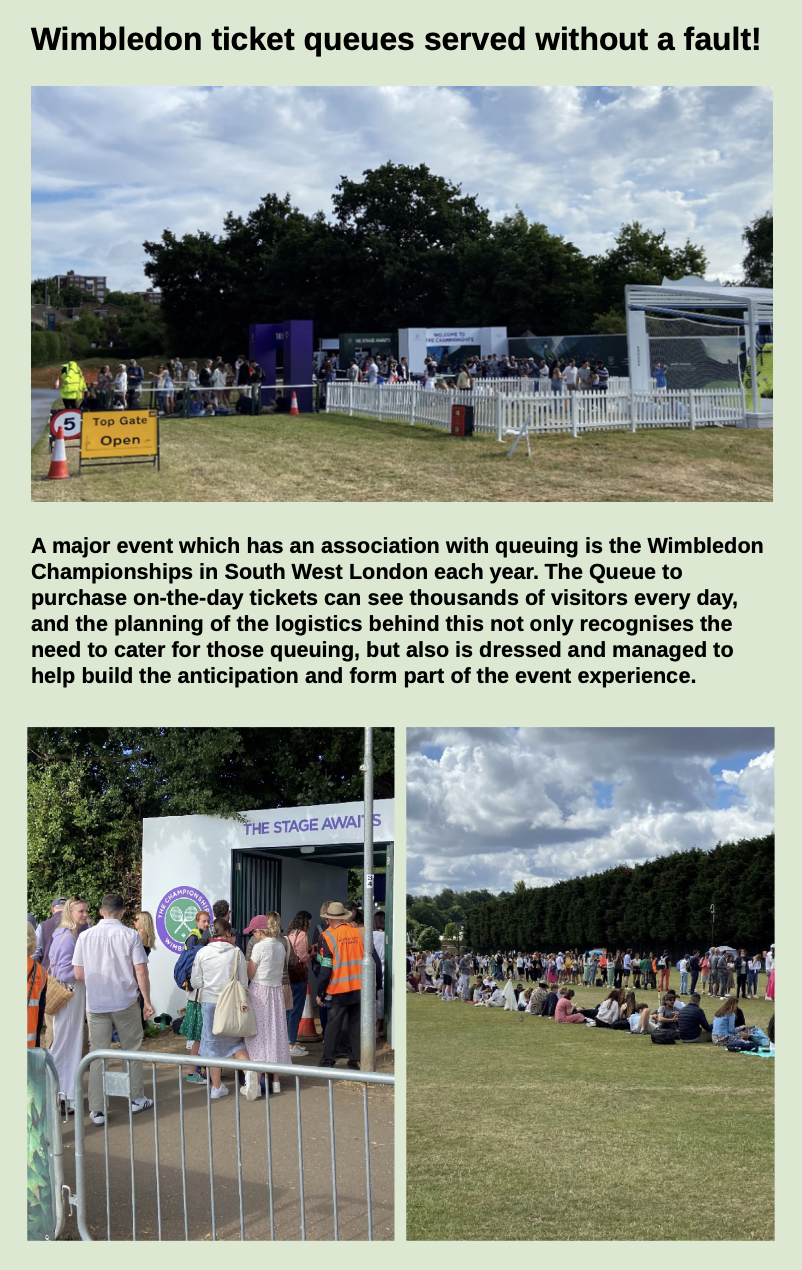TAPAS.network | 3 October 2022 | Commentary | Simon Owen
Q is for Queen. But also for Queueing – an overlooked area of transport expertise

The British obsession with queuing is a well worn cliché, but the national expression of appreciation following the death of the Queen has involved some very practical transport planning and management involving queueing theory. No more so than for the Queen’s lying-in-state at Westminster. , a specialist in pedestrian and people movement and modelling, explores some of this professional activity

The Queue for the Queen’s lying-in-state passed along the South Bank in London and took advantage of the various visitor facilities there, including the opportunity to use large outdoor screens at the South Bank Centre for displays about the Queen’s life, which will have helped enrich the queuing experience.
AS A PROFESSIONAL involved in planning for pedestrians and people movement, it’s not often that the work I and my colleagues do is top billing on the national news. In fact, most of the time, the sign that we have done our job well is that there is no mention of safety or delays when crowds are using the transport system or attending an event. The unusual – and perhaps unique – queues of up to 10 km and 15 hours to see the Queen’s lying-in-state were fascinating to both the general public and media, and to us specialists too. The fact that I have been asked to write this piece perhaps shows that there is a growing recognition of the need to acknowledge this branch of transport and event planning, and the valuable impact it can have on everyday life as well as during special occasions.
Before I explore this further, I should clarify that neither I, nor the company I work for, were involved in the preparations for the Queen’s lying-in-state. I am writing as an interested observer, albeit one with experience in the field. In fact, through a mixture of circumstance and personal interest, I’ve spent the best part of my professional career in this specialism, working for the start-up Movement Strategies since its early days in 2007, and continuing to play a role in its further development since it became part of the international multi-disciplinary engineering consultancy GHD in 2019.
My work extends across a number of identifiable elements in the worlds of transport and the built environment where there is a need for understanding and planning for people movement patterns and addressing potential problems which arise. Combining quantitative assessment and modelling with an understanding of how people move (and the motivations behind their behaviours), we identify the infrastructural changes or management interventions that are required to accommodate the anticipated demand, including the impacts of changing situations during different times of day, special events or disruptions caused by transport dislocation or weather, or indeed during emergencies. Clients include transport operators, station, terminal and interchange owners, event organisers and government organisations with a safety and security remit.
When people perceive the queue as part of the experience, it changes not only their expectations and attitudes, but also the considerations of those involved in planning and management for the process
Before looking in from the outside on any lessons or insights from the arrangements and experiences of The Queue to pass the Queen’s coffin in Westminster Hall, it’s appropriate to acknowledge that there were many people involved in the planning – too many to name here – but including representatives of the public sector, their people movement advisors and crowd management suppliers and the emergency services.
There were three aspects of the reporting and public interest in the events that struck a particular chord with me – and where I can see beneficial parallels and perhaps a prompt for better understanding of the work we do elsewhere.

1 - Queuing as an Experience
Most people’s initial thoughts when asked about queuing in their day to day lives are likely to be about the waiting experience – be it for a till at a shop, standing in line for the toilets at a concert, waiting to board or leave a bus, train, or plane, or shuffling back and forth on approach to Passport Control. While these all represent a managed outcome of a situation where demand exceeds the available capacity of a service or an activity for which there is a peak pressure, from the individual’s point of view, the delay is experienced as an inconvenience.
The Queue for the lying-in-state was ultimately a result of the demand to see the Queen’s coffin far outstripping the rate at which people could file through Westminster Hall – which was the ultimate fulfilment of the wait. But what soon became clear, was that the activity of being part of the queue was a real element of the reason for being there. Without dwelling on the psychology behind this, when people perceive the queue as part of the experience, it changes not only their expectations and attitudes, but also the considerations of those involved in planning and management for the process.

One notable example of this in more normal circumstances is The Queue for non-ticket holders at the Wimbledon Lawn Tennis Championships. Yes, at the end of the process, there is a ticket for entry to the Grounds and live tennis to watch, but for the many thousands of people involved, being part of The Queue is a memorable part of their Wimbledon experience. The All England Lawn Tennis Club and their partners put considerable effort into the planning of The Queue and ensuring that the comfort, amenity and safety of the people who choose to join is central to the management approach.
Theme Parks have taken this thinking to another level and indeed, were one of the first sectors to turn the queue on its head – achieving a situation where rides and experiences may only last a few moments but wait times can be for an hour or more, and instead of this being a problem, the queues can be used as a means of building the anticipation and providing some amusements along the way. This approach has continued to evolve, and is also now being more frequently applied at other visitor attractions and some transport locations – using design and active management to change a frustrating wait into an engaging part of the experience.

2 - Quantifying The Queue
As the news cycle relating to the death of the Queen and its consequences evolved during the Mourning Period, greater attention was given by the media to the planning that went behind the design of The Queue, and the people involved in that. The recognition that such planning takes place, and that there is in fact ‘science’ involved, actually changed the nature of the conversations I was having with friends and family, who became interested in ‘how do you know how big the queue is going to be...?’ and ‘how do you deal with too many people turning up?’
Understanding the ‘process rate’ – i.e. how many people could enter Westminster Hall in a given period – was one key aspect that could be estimated, and thus became the building block for everything that followed. Many of our pedestrian studies start with quantifying such process rates, be they throughput at a security search, transaction rates at a point of sale, or ‘flush rates’ within toilets. As specialists, we have often provided insight and advice on improving the experience and minimising delays through the capture and analysis of these operational processes.
Where The Queue could be safely accommodated would also have been something informed by numbers. Identifying an available space would in turn be influenced by knowing the ‘baseline’ activity – what is the normal level and pattern of movement along the available routes? The Queue would obviously need to be facilitated, but ideally not cause disruption to the ‘day to day’ amenity of the city and the people who rely on these routes for their ordinary journeys. Capturing data on background ‘traffic’ is a well understood principle of transport planning work for vehicular and passenger traffic with a long track record of ongoing collection of this information in specific locations – particularly in a volumetric sense. For pedestrians, however, this is not yet generally the case, although the technological advances in recent years are opening up an increased propensity to automatically capture and visualize not only pedestrian volumes at specific locations, but also more information on origins and destinations of journeys made on foot. Transport bodies have led the way in exploring opportunities this area, notably the main airports and Transport for London.
Another metric is that the number of people who can be ‘queued’ at any one time is a function of the space available and the density of the people within that space. It is important to recognize in this regard that much of the guidance available around the management of crowds is related to emergency conditions and assurance of safety, where higher densities may be expected and tolerated. My earlier point on queuing as an experience, is a key one here. In waiting to pay their respects to the Queen, people would have spent many hours in The Queue, and as Westminster Hall remained open throughout the night, for most of the time people would have been on the move or only static for short periods. Understanding the implications of these factors on the average density of people together is important in understanding the realistic capacity of The Queue, and identifying how far people would be from the end, and when they are reaching different feature points.
The main unknown was the volume and profile of demand to view the lying-in state. As with any transport planning activity, the availability of a forecast would be the natural starting point. But such an event had not happened for over 70 years, and even in this new instance, the timing of the event would obviously be unknown until a handful of days before, and the precise circumstances e.g. time of the year and the weather were therefore not predictable. As such, the focus would have been on scenario planning – and understanding what the outcomes would be for a range of circumstances and viable demand profiles. Cross-referencing these against the available space for The Queue would have identified in which scenarios this would be exceeded, and allowed the creation of a framework for messaging and supervision and control to manage demand. Luckily, London has considerable experience of this approach – ranging from previous Jubilee and Royal Wedding Celebrations, to the London Olympics and City Centre activations managed by TfL in 2012. How best to manage such pressures was evidenced in the communications approach adopted for the late Queen’s arrangements.

Queueing is a major feature of both theme parks and airports. Those responsible for both have developed techniques for management and engagement of participants, with the leisure operators keeping people engaged and excited whilst they wait for long periods to enjoy a relatively short ride experience such as on a rollercoaster. At airports, there is an expectation of queues to check in, board a flight or pass through border control. In these circumstances the best help is the provision of information about expected wait times and assurance that they are making progress to their end goal.
3 - Benefits of Communication
At the heart of a successful queueing operation is keeping those involved well-informed and therefore reducing frustration, and more comfortable with the progress they are making and thus confident that it will all be worthwhile.
For the Queen’s lying-in-state, the latest digital information systems were deployed, including the app that showed both the routing of the queue, facilities along it and current progress of those in it and estimated waiting times. This was leaned on by the main media outlets, and became the ‘source of truth’ being reported across the world. At a practical level, the availability of this information so widely and in close to real time provided significant benefits in terms of journey planning, and therefore minimizing the impact on London’s travel system and the pedestrian networks in Westminster, Southwark and the City. The ability for someone joining the back of the queue to know where it is at the current time would have meant that they could make the decision whether to travel at all, and if so, head towards the nearest station. This would avoid them heading to Westminster Hall and then receiving information that they then had to walk all the way to the start of the queue down in South East London at Southwark Park, where a particular crowd management operation was in place, with large numbers of barriers and staff.
This may not seem surprising, or maybe indeed a point worth dwelling on, but it is often something that comes up in pedestrian movement planning – how a lack of information at the right time can lead to ‘unnecessary’ journeys and a negative experience. This is often an area where we advise our clients not just on the space required to accommodate flows and queues, but also indications at what locations and times people require information in order to make the right decisions. The flow through from planning to operations is paramount, and the Queen’s lying-in-state is an excellent example of where this has been delivered effectively.
All’s well that ends well
As a professional involved in pedestrian movement, it was rewarding to see The Queue arrangements for the Queen’s lying- in-state receive the attention it did. There seemed to be a generally positive response to the arrangements from those who took part – the best estimate of which is that around 300,000 people queued to enter Westminster Hall over the five-day period. The shared experience those people had in The Queue will have been a memorable one and could become part of the folklore of the event. Most of the time the planning and preparation for efficient and effective queueing is something that goes unnoticed and unremarked, so it has been refreshing to see the work we do get the attention it deserves!
Simon Owen is Sports and Events Lead at Movement Strategies (A GHD Company). From starting his career as a transport planner, Simon has been involved in the provision of people and crowd movement advice for over 15 years, and has supported the planning of high profile events from The London Olympics of 2012 to this summer’s Commonwealth Games in Birmingham, numerous stadia and cultural venues and a number of the UK’s largest train stations.
This article was first published in LTT magazine, LTT854, 3 October 2022.
You are currently viewing this page as TAPAS Taster user.
To read and make comments on this article you need to register for free as TAPAS Select user and log in.

Log in